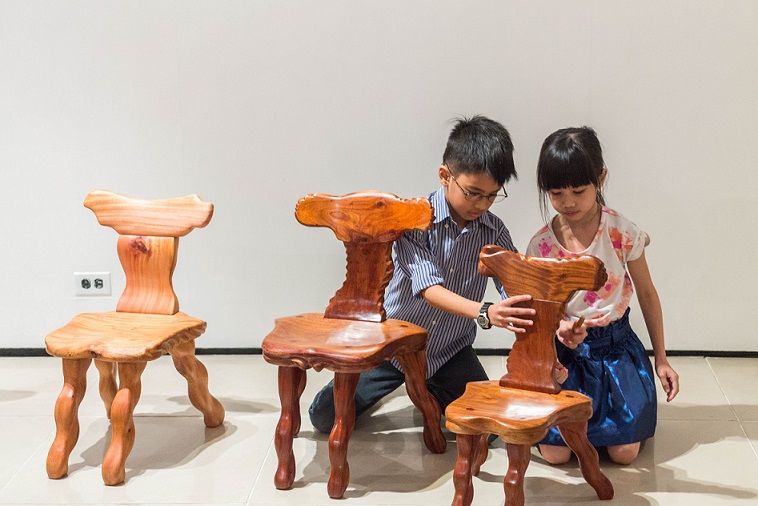
Two children inspect chairs built for their size.
When you grow up with and come of age as a son of a great man like Jerusalino V. Araos, who in his lifetime excelled as sculptor, gardener, writer and father, whatever you do is set against a very high standard. Maybe you would rather seek your niche in a field like molecular chemistry.
But Jemil Araos, in his early 40s, is measuring up to his father’s code. Proof of this is his show of sculptures “Artfully Araos” at the Sining Makiling Gallery located at the basement of the Leandro Locsin-designed D.L. Umali Hall, University of the Philippines Los Baños (UPLB) in Laguna. The exhibit runs until Nov. 10.
Upon entering the gallery, one notices the row of adult and children’s chairs. One feels like the children’s storybook character Goldilocks wandering into the house of the three bears. Young Araos calls these “alembong chairs” because their anthropomorphic forms, suitable for the human body’s scale, are carved with so much grace and flirtatiousness. One cannot help but caress the grooves and smooth bumps all the way under and at the back of the chairs.

A family of chairs and one long bench
No two chairs are alike although they may look similar. What’s certain is they follow the human skeletal form and, as JR Yapo’s exhibit notes state, “allow for relatively freer movement of the torso and its peripherals.”
This is the trademark of both Jerry and Jemil Araos. They shun the architectonic form of sculpture that follows the scale of the inside and outside of buildings and houses. Father and son are humanists and life-loving humans, quick to joke, quick to show compassion for fellow sojourners in this world.
Araos’s materials are typhoon-felled logs, mainly narra and mahogany. He also sourced some wood from demolished old houses. A human ecology graduate of UPLB, he has applied his academic knowledge in his aesthetics and day-to-day life. He sculpted the works on exhibit in his farm in Calauan. After a few hours of this, he would unwind by feeding his pigs or cleaning their stool. When he reached home, he was not spared from housework. His task: to wash the dishes.

The artist seated on an Alembong chair
What made him more nervous while preparing for the show was the little speech he had to prepare for the opening program. He told himself, “I am an Araos, and Araoses are known to be magiting (brave) so I’ll have to do it.” At the program, he put the standing room audience at ease by confessing his nervousness. After that, everything was a breeze. He entertained every visitor, demonstrating the uses of and ways to display his functional art.
He climbed onto a rough-hewn bench to show how he did his mother and child sculptures. This low bench is modeled after the size of benches that Igorot carvers are at home in when doing their work. In this show and tell format, young Araos most resembles his father, the stentorian, authoritative voice included.
Of his decorative art, he described one of his early mother and child sculptures as copied from a nude found in a book on National Artist Fernando Amorsolo. Araos said, “I couldn’t afford to hire a model then so I copied and called the torso ‘Amor’ after Amorsolo.”
Another torso has vertical detailing at the top to stand for the bangs of his dear friend, cultural executive Cora Alvina. He likes to give his torsos identifiable characteristics to make them more personal.

Anthropomorphic chairs and mother and child sculpture
